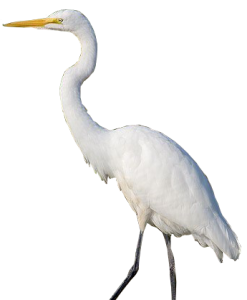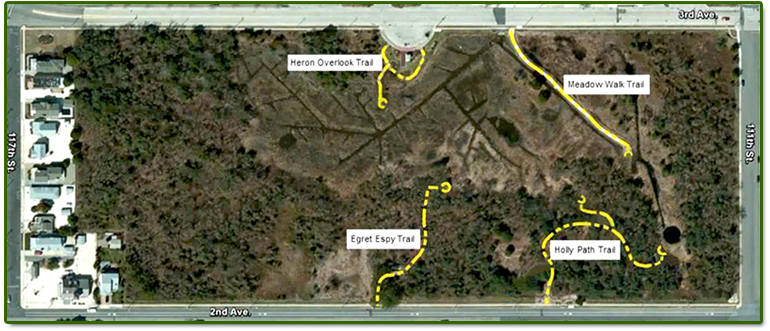Heron Overlook Path
Located off 3rd Avenue and surrounded by beautiful gardens donated by Friends of the Sanctuary, Heron Overlook will allow you to view the saltwater wetlands which are a popular heron and egret feeding area. In the spring and fall, you might see and hear Neotropical songbirds as well as other larger migratory visitors. Take a moment, sit on a bench, enjoy the views and listen to the birds.
In the fall, monarch butterflies have been known to swarm the flower gardens on their way south. The Heron Overlook Path was made possible through the generous support of Julian and Betsy Miraglia as well as Phil Barber and Tony Millcarsky.
Please stop at the Pump House, open the brown stand and tell us who you are, where you are from and any birds you have seen!
Meadow Walk Path
Also located on 3rd Avenue amid beautiful gardens donated by Friends of the Sanctuary, the Meadow Walk Path is surprisingly unique because it straddles fresh water meadows on your left and salt water marsh on your right. In the spring and summer, you might see Great White and Great Blue Herons stalking minnows and fiddler crabs in the tributaries. In the fall, various types of ducks can be seen swimming in the fresh water marsh to the right.
The Meadow Walk path ends with a view of Paul’s Pond, a fresh water spring-fed pond where you might see Glossy Ibis, Black-crowned Night Heron, Yellow-crowned Night Heron, Green Heron and Osprey roosting in the trees in front of you.
The Meadow Walk was created by the Cape May County Department of Mosquito Control with help from the Friends of the Sanctuary.
Egret Espy Path
The entrance to the Egret Espy Path is located off 2nd Avenue and 114th Street. You are greeted at the beginning of the path by a stand of whispering pine trees planted by local Boy Scouts after the 1962 storm. Take a moment and sit on one of the teak benches, breathe in the soft pine scent and enjoy the beautiful gardens donated by Friends of the Sanctuary. As you walk along the path, you will cross a footbridge dedicated in honor of long-time resident, George Walters. Once across the bridge, you enter Maritime forest that is hundreds of years old. To your right and left you will see intricate, artistic remnants of old white spruce. Watch out, you might step on an Eastern Box Turtle!
At the end of the path, sit on one of the benches, listen but keep your eyes open because you are likely to see migrating songbirds, Green Herons, colonial wading birds, and large, colorful dragon flies. The path is alive with activity.
Holly Path

The Holly Path meanders across ancient sand dunes and an rare Maritime Forest. Stands of sassafras, black cherry, American holly, and Eastern red cedar abound. A trail spur, meanders past a 300 year old holly tree perched on a 15’ dune. A ghost Atlantic white cedar and large hackberry, with its distinctive knobby bark, are some of the unusual discoveries found along Holly Path. In recent years, several wind storms have toppled trees in the forest where time will gradually reclaim them back into the forest floor.
The Maritime Forest here borders the freshwater marsh and Paul’s Pond. Black-crowned Night Herons frequent the trees around Holly Path and in an effort to minimize disturbance, Holly Path has been closed to visitors during the summer. Holly Path is now open year-round, but we ask that if you are using the Holly Path between March through October that you enjoy nature quietly and remain on the trail.



